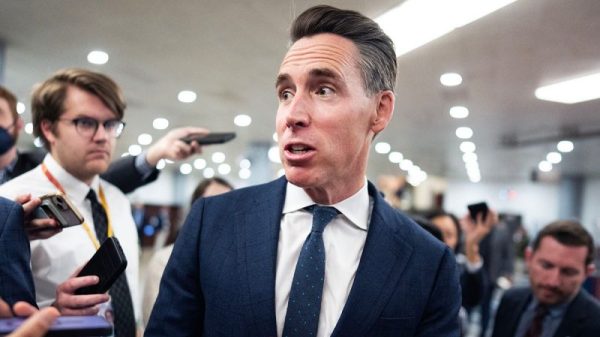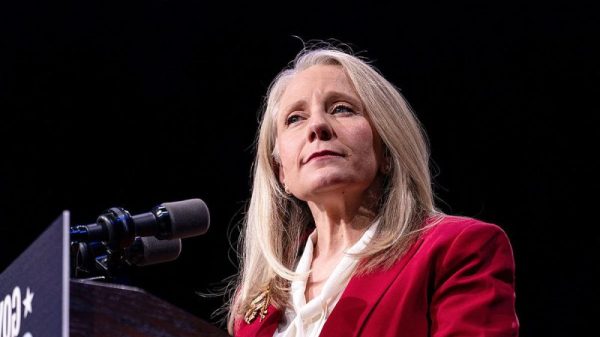It is less than a week until the Iowa caucuses, a hackneyed introductory phrase that, in four days, will transform into something like, “At long last, voters get their say.” But the point remains that voting (or whatever you want to call what they do in Iowa) is imminent and the march toward the Republican presidential nomination is about to begin.
Particularly given the tumult in that race this week — with former New Jersey governor Chris Christie dropping out and Donald Trump holding a rally on Fox News while his challengers duke it out on CNN and entrepreneur Vivek Ramaswamy is off doing his angry thing — it’s less clear than ever how the race will unfold, even if there remains little question about what the eventual result will be.
With that in mind, we put together a calendar of the first seven weeks of voting — a period that will allocate nearly enough delegates for a candidate to theoretically clinch the nomination — along with an assessment of how those delegates might be distributed.
But that’s not where we should start. We should, instead, start with our quadrennial look at how the nominating contests work.
The Republican Party, like the Democratic Party, will formally nominate its presidential candidate during its convention this summer. A few decades ago, that meant that the congregated party representatives rubber-stamped the establishment pick. More recently, it means that delegates won by candidates in caucuses or primaries cast their votes according to those results. There are 2,429 delegates in total, meaning that a candidate needs to lock up 1,215 before the convention to clinch the nomination.
Winning those delegates, though, comes down to more than just winning more votes. It also comes down to three factors that govern each state’s contest: what type of contest it is, who’s allowed to participate and how delegates are distributed.
The type of contest. Republican nominating fights are usually primaries, the typical vote-for-who-you-want sort of election we’re used to. Iowa uses a caucus system that depends on people showing up and spending a few hours fighting over who they want. Other states hold conventions in which designated participants select how they want to allocate delegates.
Caucuses are more dependent on good organizing compared with primaries, which advantages campaigns that are better-run and -resourced.
Who participates. Some states, including Iowa, let only registered Republicans weigh in. This is called a closed primary or caucus. Other states, such as New Hampshire, let some non-Republicans participate. Then there are such states as South Carolina, where anyone can cast a ballot — what’s known as an open primary.
This is important! Polling has repeatedly shown that former ambassador to the United Nations Nikki Haley fares better with independents than with Republicans, so a contest in which non-Republicans can vote helps her relative to Trump.
How delegates are allocated. States have different rules around allocating delegates, too.
In some places, delegates are awarded proportionally: win 40 percent of the vote and you get about 40 percent of the delegates. Since delegate totals are dependent in part on how many representatives the state has, this proportional distribution can be done at the House-district level, too.
Often, the distribution requires that candidates hit a certain percentage of support to get any delegates, a boundary often referred to as the state’s threshold. Some states have thresholds of 20 percent or so, meaning that a candidate who gets 19 percent of the vote in the state or in a district is shut out of delegates.
The Republican Party has a lot of winner-take-all or winner-take-most states, too — systems that advantage the front-runner and can more quickly settle the nomination.
In the former, the candidate who wins the state gets its delegates, easy-peasy. In the latter, the statewide winner might get a big chunk of the delegates and the winners of the districts get the rest — which is often the candidate who won the state. In other places, the delegates are awarded by mixing and matching. In Maine, for example, if you get 50 percent statewide, you win all the delegates, but coming up short shifts allocation to a proportional system with a 20 percent threshold.
There’s one other important consideration over the next seven weeks, too: who stays in the race.
At one point in this nominating fight, there were more than a dozen declared candidates. But, in part because Trump’s lead has been so dominant and in part because flying to Iowa all the time is expensive, many candidates have since dropped out. (Others have stayed in despite polling in the low single digits; these candidates often don’t spend a lot of money flying to Iowa.) This makes it easier for the front-runner (Trump) to hit 50 percent thresholds, but it also makes it easier for his opponents to clear lower thresholds.
It’s probably safe at this point to view the field as consisting of four main candidates: Trump, Haley, Florida Gov. Ron DeSantis and Ramaswamy. Christie’s departure on Wednesday, though, gives us a good opportunity to consider how votes can shift.
Consider Iowa, where Haley passed DeSantis for the first time in a new poll from Suffolk University — though she still trails Trump by a wide margin. We can now consider what that means for the Iowa caucuses: Where do Christie’s supporters go, if anywhere?
And to consider that, we might as well jump into our calendar.
40 delegates added. 3.3 percent of the number needed to clinch is now available.
Suffolk’s poll considered this question. David Paleologos, the poll’s director, posted the top-line results on social media: Trump at 54 percent, Haley at 20, DeSantis at 13 and Christie at 2. But he also posted the results after reallocating Christie’s support — all of which goes to Haley.
That doesn’t really matter much here, since the former New Jersey governor had only 2 percent in the first place. That is good news for Trump, who has twice before run campaigns for the Iowa caucuses and twice before won the state’s presidential electors. He has a big lead and an established team, strong indicators that he will win the caucuses and most of its delegates.
22 delegates added. 5.1 percent of the number needed to clinch is now available.
Christie’s departure might be more important in New Hampshire. There, a separate Suffolk poll put Christie at 12 percent to Trump’s 46 percent and Haley’s 26 percent.
Asked who their second pick would be, 7 percent of Christie supporters said Trump while about half said Haley. (The margins of error are very big here, it’s important to note.) The rest said they were undecided or named someone else.
Other polls, including one from CNN this week, have shown Haley much closer to Trump. Give her most of Christie’s vote and her odds of winning the state (as its governor predicted) become more believable.
But there are two catches.
The first is that New Hampshire is a proportional state, meaning that a narrow win will give Haley about the same number of delegates as Trump earns. (The best source for information about primary processes is the Green Papers.)
We can do some rough math. Win 47 percent of the vote to your opponent’s 45 and you get around 51 percent of the delegates to his 49 percent (since the threshold of 10 percent in New Hampshire means that no other candidates get delegates). That means (again, roughly!) 11 delegates apiece.
The second is that there’s no guarantee that Ramaswamy and DeSantis will stay in the race if they perform badly in Iowa. If DeSantis drops out before New Hampshire, Suffolk’s poll says his support in New Hampshire — 8 percent — will be split between Trump and Haley. Ramaswamy’s more modest support would go mostly to Trump and DeSantis, should the Florida governor stay in.
34 delegates added. 7.9 percent of the number needed to clinch is now available.
The next contest is two weeks later. Nevada will have had a primary two days before its Feb. 8 caucuses, but the state party is allocating its delegates based on the caucus outcomes. Primary fights often get caught up in weird power struggles, and Nevada is no exception. In this case, anyone on the primary ballot can’t be on the caucus one — meaning they can’t win any delegates.
Haley is on the primary ballot.
In theory, especially if she does well in the New Hampshire primary, this could mean that she easily wins the primary and starts talking about her huge momentum. This was a tactic used by Sen. Bernie Sanders (I-Vt.) in 2016, attempting to convince supporters and donors that winning a lot of unimportant contests was a sign of his strength. But it didn’t do him much good over the long term.
Trump has a huge lead in the most recent polling in Nevada, so while Haley would get a hollow victory on Feb. 6, Trump would get a big, meaningful one in short order.
50 delegates added. 12 percent of the number needed to clinch is now available.
South Carolina would seem to be friendly terrain for Haley, who used to serve as the state’s governor. But polling has consistently shown Trump with a big lead. Maybe Haley will be successful enough in the first three contests that this pattern shifts. Or maybe it won’t.
There are two mechanical considerations here. The first is that South Carolina is an open primary, which may better position Haley — especially if there’s a robust effort to turn out non-Republicans to derail Trump. The second, though, is that the state is winner-take-all. If Trump beats Haley by a percentage point, he is likely to add most of the 50 delegates at stake to his total. (The possible exception is if Haley wins a House district or two.)
135 delegates added. 23.1 percent of the number needed to clinch is now available.
There are four more states that vote between South Carolina and Super Tuesday (see below) that will allocate a chunk of delegates. By this point, the nominating fight will probably be either Trump vs. Haley (plus a random other person or two) — or just Trump, particularly if Haley loses badly in her home state. If Haley is still in, they’re all closed, playing to Trump’s advantage.
874 delegates added. 95.1 percent of the number needed to clinch is now available.
Then we get to Super Tuesday, a day on which 72 percent of the delegates needed to clinch will be on the table. Only two contests, Alaska and Colorado, are proportional; the rest are winner-take-most or winner-take-all. Or, like Maine, winner-take-all if a candidate gets 50 percent statewide and proportional if one doesn’t.
Suffice it to say that Trump should probably be well-positioned when March 6 dawns.
Probably. It’s certainly possible that Haley wins New Hampshire robustly and shifts the trend of the contest, though that hasn’t generally been the pattern and, unlike past candidates who did see a post-New Hampshire resurgence, she’s running against a popular candidate for whom most primary voters have probably voted in the past. Heck, maybe even DeSantis will still be in, who knows?
But consider what happened in 2016. For the first few contests, Trump was in a real fight, even losing the Iowa caucuses. Narrow wins, though, often gave him a lopsided number of delegates; by early May, even while battling hard against several candidates, he finally cleared the field.
This year will probably be easier — and probably end earlier.
It is less than a week until the Iowa caucuses, a hackneyed introductory phrase that, in four days, will transform into something like, “At long last, voters get their say.” But the point remains that voting (or whatever you want to call what they do in Iowa) is imminent and the march toward the Republican presidential nomination is about to begin.
Particularly given the tumult in that race this week — with former New Jersey governor Chris Christie dropping out and Donald Trump holding a rally on Fox News while his challengers duke it out on CNN and entrepreneur Vivek Ramaswamy is off doing his angry thing — it’s less clear than ever how the race will unfold, even if there remains little question about what the eventual result will be.
With that in mind, we put together a calendar of the first seven weeks of voting — a period that will allocate nearly enough delegates for a candidate to theoretically clinch the nomination — along with an assessment of how those delegates might be distributed.
But that’s not where we should start. We should, instead, start with our quadrennial look at how the nominating contests work.
The Republican Party, like the Democratic Party, will formally nominate its presidential candidate during its convention this summer. A few decades ago, that meant that the congregated party representatives rubber-stamped the establishment pick. More recently, it means that delegates won by candidates in caucuses or primaries cast their votes according to those results. There are 2,429 delegates in total, meaning that a candidate needs to lock up 1,215 before the convention to clinch the nomination.
Winning those delegates, though, comes down to more than just winning more votes. It also comes down to three factors that govern each state’s contest: what type of contest it is, who’s allowed to participate and how delegates are distributed.
The type of contest. Republican nominating fights are usually primaries, the typical vote-for-who-you-want sort of election we’re used to. Iowa uses a caucus system that depends on people showing up and spending a few hours fighting over who they want. Other states hold conventions in which designated participants select how they want to allocate delegates.
Caucuses are more dependent on good organizing compared with primaries, which advantages campaigns that are better-run and -resourced.
Who participates. Some states, including Iowa, let only registered Republicans weigh in. This is called a closed primary or caucus. Other states, such as New Hampshire, let some non-Republicans participate. Then there are such states as South Carolina, where anyone can cast a ballot — what’s known as an open primary.
This is important! Polling has repeatedly shown that former ambassador to the United Nations Nikki Haley fares better with independents than with Republicans, so a contest in which non-Republicans can vote helps her relative to Trump.
How delegates are allocated. States have different rules around allocating delegates, too.
In some places, delegates are awarded proportionally: win 40 percent of the vote and you get about 40 percent of the delegates. Since delegate totals are dependent in part on how many representatives the state has, this proportional distribution can be done at the House-district level, too.
Often, the distribution requires that candidates hit a certain percentage of support to get any delegates, a boundary often referred to as the state’s threshold. Some states have thresholds of 20 percent or so, meaning that a candidate who gets 19 percent of the vote in the state or in a district is shut out of delegates.
The Republican Party has a lot of winner-take-all or winner-take-most states, too — systems that advantage the front-runner and can more quickly settle the nomination.
In the former, the candidate who wins the state gets its delegates, easy-peasy. In the latter, the statewide winner might get a big chunk of the delegates and the winners of the districts get the rest — which is often the candidate who won the state. In other places, the delegates are awarded by mixing and matching. In Maine, for example, if you get 50 percent statewide, you win all the delegates, but coming up short shifts allocation to a proportional system with a 20 percent threshold.
There’s one other important consideration over the next seven weeks, too: who stays in the race.
At one point in this nominating fight, there were more than a dozen declared candidates. But, in part because Trump’s lead has been so dominant and in part because flying to Iowa all the time is expensive, many candidates have since dropped out. (Others have stayed in despite polling in the low single digits; these candidates often don’t spend a lot of money flying to Iowa.) This makes it easier for the front-runner (Trump) to hit 50 percent thresholds, but it also makes it easier for his opponents to clear lower thresholds.
It’s probably safe at this point to view the field as consisting of four main candidates: Trump, Haley, Florida Gov. Ron DeSantis and Ramaswamy. Christie’s departure on Wednesday, though, gives us a good opportunity to consider how votes can shift.
Consider Iowa, where Haley passed DeSantis for the first time in a new poll from Suffolk University — though she still trails Trump by a wide margin. We can now consider what that means for the Iowa caucuses: Where do Christie’s supporters go, if anywhere?
And to consider that, we might as well jump into our calendar.
40 delegates added. 3.3 percent of the number needed to clinch is now available.
Suffolk’s poll considered this question. David Paleologos, the poll’s director, posted the top-line results on social media: Trump at 54 percent, Haley at 20, DeSantis at 13 and Christie at 2. But he also posted the results after reallocating Christie’s support — all of which goes to Haley.
That doesn’t really matter much here, since the former New Jersey governor had only 2 percent in the first place. That is good news for Trump, who has twice before run campaigns for the Iowa caucuses and twice before won the state’s presidential electors. He has a big lead and an established team, strong indicators that he will win the caucuses and most of its delegates.
22 delegates added. 5.1 percent of the number needed to clinch is now available.
Christie’s departure might be more important in New Hampshire. There, a separate Suffolk poll put Christie at 12 percent to Trump’s 46 percent and Haley’s 26 percent.
Asked who their second pick would be, 7 percent of Christie supporters said Trump while about half said Haley. (The margins of error are very big here, it’s important to note.) The rest said they were undecided or named someone else.
Other polls, including one from CNN this week, have shown Haley much closer to Trump. Give her most of Christie’s vote and her odds of winning the state (as its governor predicted) become more believable.
But there are two catches.
The first is that New Hampshire is a proportional state, meaning that a narrow win will give Haley about the same number of delegates as Trump earns. (The best source for information about primary processes is the Green Papers.)
We can do some rough math. Win 47 percent of the vote to your opponent’s 45 and you get around 51 percent of the delegates to his 49 percent (since the threshold of 10 percent in New Hampshire means that no other candidates get delegates). That means (again, roughly!) 11 delegates apiece.
The second is that there’s no guarantee that Ramaswamy and DeSantis will stay in the race if they perform badly in Iowa. If DeSantis drops out before New Hampshire, Suffolk’s poll says his support in New Hampshire — 8 percent — will be split between Trump and Haley. Ramaswamy’s more modest support would go mostly to Trump and DeSantis, should the Florida governor stay in.
34 delegates added. 7.9 percent of the number needed to clinch is now available.
The next contest is two weeks later. Nevada will have had a primary two days before its Feb. 8 caucuses, but the state party is allocating its delegates based on the caucus outcomes. Primary fights often get caught up in weird power struggles, and Nevada is no exception. In this case, anyone on the primary ballot can’t be on the caucus one — meaning they can’t win any delegates.
Haley is on the primary ballot.
In theory, especially if she does well in the New Hampshire primary, this could mean that she easily wins the primary and starts talking about her huge momentum. This was a tactic used by Sen. Bernie Sanders (I-Vt.) in 2016, attempting to convince supporters and donors that winning a lot of unimportant contests was a sign of his strength. But it didn’t do him much good over the long term.
Trump has a huge lead in the most recent polling in Nevada, so while Haley would get a hollow victory on Feb. 6, Trump would get a big, meaningful one in short order.
50 delegates added. 12 percent of the number needed to clinch is now available.
South Carolina would seem to be friendly terrain for Haley, who used to serve as the state’s governor. But polling has consistently shown Trump with a big lead. Maybe Haley will be successful enough in the first three contests that this pattern shifts. Or maybe it won’t.
There are two mechanical considerations here. The first is that South Carolina is an open primary, which may better position Haley — especially if there’s a robust effort to turn out non-Republicans to derail Trump. The second, though, is that the state is winner-take-all. If Trump beats Haley by a percentage point, he is likely to add most of the 50 delegates at stake to his total. (The possible exception is if Haley wins a House district or two.)
135 delegates added. 23.1 percent of the number needed to clinch is now available.
There are four more states that vote between South Carolina and Super Tuesday (see below) that will allocate a chunk of delegates. By this point, the nominating fight will probably be either Trump vs. Haley (plus a random other person or two) — or just Trump, particularly if Haley loses badly in her home state. If Haley is still in, they’re all closed, playing to Trump’s advantage.
874 delegates added. 95.1 percent of the number needed to clinch is now available.
Then we get to Super Tuesday, a day on which 72 percent of the delegates needed to clinch will be on the table. Only two contests, Alaska and Colorado, are proportional; the rest are winner-take-most or winner-take-all. Or, like Maine, winner-take-all if a candidate gets 50 percent statewide and proportional if one doesn’t.
Suffice it to say that Trump should probably be well-positioned when March 6 dawns.
Probably. It’s certainly possible that Haley wins New Hampshire robustly and shifts the trend of the contest, though that hasn’t generally been the pattern and, unlike past candidates who did see a post-New Hampshire resurgence, she’s running against a popular candidate for whom most primary voters have probably voted in the past. Heck, maybe even DeSantis will still be in, who knows?
But consider what happened in 2016. For the first few contests, Trump was in a real fight, even losing the Iowa caucuses. Narrow wins, though, often gave him a lopsided number of delegates; by early May, even while battling hard against several candidates, he finally cleared the field.
This year will probably be easier — and probably end earlier.





















